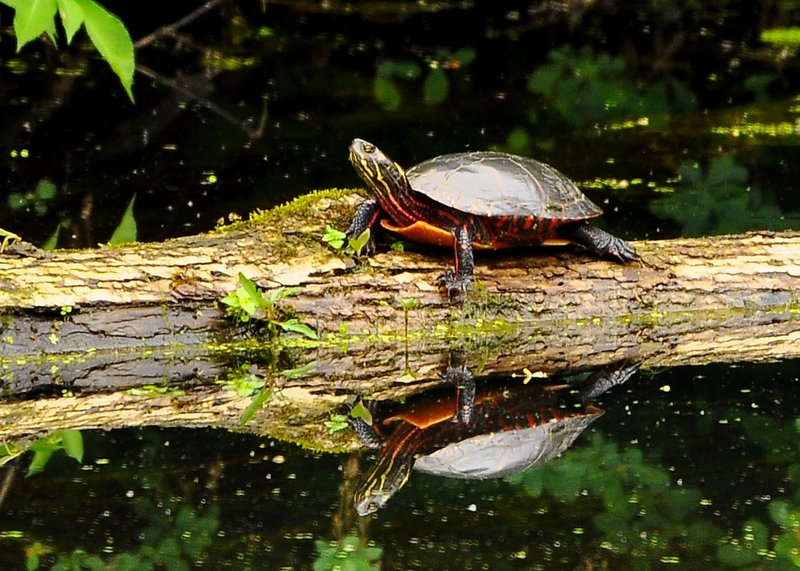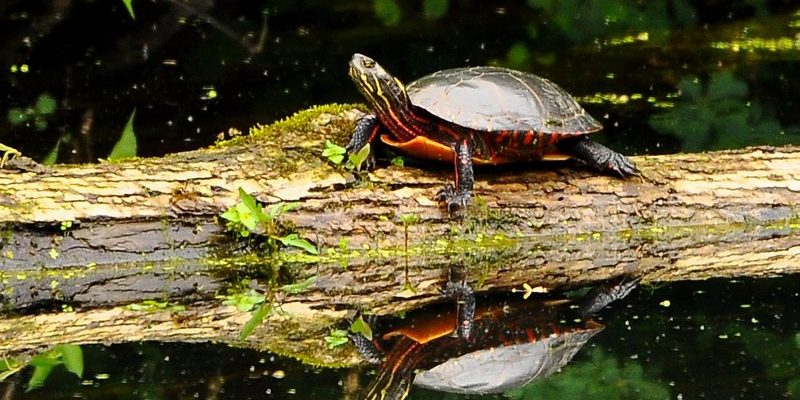
Picture yourself lounging by a serene pond, watching these turtles bask in the sun, their beautiful shells gleaming. You might wonder how these turtles manage to withstand changing seasons, evade predators, and even thrive in pollution-heavy waters. Let’s take a closer look at their unique adaptations that make them not just survivors but champions of resilience in the wild.
1. A Beautiful Armor: The Painted Shell
The painted turtle’s most recognizable feature is its vibrant shell. But this isn’t just for show; it serves a vital purpose. The hard outer layer acts as a protective shield against predators—think of it as a medieval knight’s armor, designed to keep them safe from unwanted bites and attacks. When faced with danger, painted turtles can retract their heads and limbs into their shells, securing themselves in a pretty sturdy fortress.
Another critical function of their shells is to help with temperature regulation. Turtles are ectothermic, meaning they rely on external sources for heat—like the sun. Their colorful shells can absorb sunlight, warming them up when they need it. However, when temperatures soar, they can cool off by slipping into the water or seeking shade. It’s a clever balancing act that keeps them comfortable and safe.
2. Master of the Water: Webbed Feet
Painted turtles are excellent swimmers, and a lot of that comes down to their webbed feet. These feet are like the perfect paddles, allowing them to glide effortlessly through the water. When you see them paddle along, it almost looks like they’re dancing, right? Their webbed toes help them propel forward and steer with ease, making them quick escapes when predators like herons or raccoons approach.
Swimming is not just about evading danger; it’s crucial for finding food too. Painted turtles enjoy a diverse diet, munching on aquatic plants, insects, and even small fish. Their swimming prowess helps them forage effectively, ensuring they get the nutrients they need to thrive. It’s all about the right adaptations in the right environment!
3. The Power of Basking
You might often see painted turtles basking in the sun on logs or rocks. This behavior isn’t just for relaxation; it’s another adaptation that plays a huge role in their survival. Basking helps them absorb heat, which is essential for their metabolism and digestion. Just imagine how much energy you’d have after a warm, sunny day out!
Moreover, soaking up sunlight helps turtles produce vitamin D3, which is crucial for their bone health. Without this sunlight exposure, they can face serious health issues, similar to how humans need vitamin D. So, the next time you see a turtle lounging about, you can appreciate that they’re not just sunbathing—they’re fortifying their health for the adventures ahead!
4. Breathing Techniques: A Lungy Advantage
Unlike many other aquatic creatures, painted turtles have lungs and must come to the surface to breathe air. But they are clever about it. When they dive underwater, they can hold their breath for up to 30 minutes or longer, especially when in a relaxed state. This ability helps them evade predators while also allowing them to stay submerged while searching for food.
Interestingly, painted turtles can also absorb some oxygen through their skin while resting at the bottom of a pond. It’s like having a backup plan! This ability allows them to stay hidden and safe, making them less vulnerable while still getting the oxygen they need.
5. Hibernation: A Winter Survival Strategy
When winter rolls in and the weather turns frigid, many animals go into a deep slumber. Painted turtles have their own version of this—hibernation. They find a cozy spot in the mud at the bottom of ponds and lakes to wait out the cold months. It’s kind of like curling up in a warm blanket for the winter!
During hibernation, their metabolism slows down significantly, allowing them to survive without food for extended periods. This adaptation is crucial since finding food in icy waters is nearly impossible. With this strategy, they can emerge in spring, ready to bask and feed, just in time for the warmer months.
6. Colorful Camouflage: Blending In
The stunning colors of a painted turtle aren’t just pleasing to the eye; they play a role in their survival too. Their bright markings can help them blend into their surroundings, especially among the colorful plants and algae of their aquatic habitats. When you think about it, being a little like a chameleon can work wonders in avoiding predators.
Moreover, their darker shells can help them absorb sunlight for warmth, while the vibrant patterns can confuse potential threats. Think of it as nature’s way of equipping them with both charm and cunning—two essential traits for a survivor!
7. Resilience to Pollution: An Unexpected Adaptation
With increasing pollution in many water bodies, you’d expect painted turtles to struggle. Surprisingly, these turtles have shown some adaptability to less-than-ideal water conditions. They can live in murky waters where many animals wouldn’t survive. While this doesn’t mean they thrive in polluted environments, it shows their resilience.
However, it’s essential to note that pollution can still impact their health. They’re more vulnerable to toxins, which can affect their immune systems and overall well-being. It’s a reminder that while they’re survivors, they still need a healthy and clean environment to flourish.
8. Social Creatures in Their Own Right
While painted turtles may seem solitary when basking, they’re social creatures. They often bask together on logs or rocks, and this social behavior can be a survival tactic too. By grouping together, they can increase their chances of spotting predators. If one turtle senses danger, they can quickly alert the rest, allowing for a quick retreat into the water.
Socializing also plays a role in their mating behaviors and finding a partner. The social dynamics among painted turtles demonstrate that even in the wild, teamwork can be a crucial strategy for survival.
As we wrap up this exploration of the painted turtle’s adaptations, it’s clear these colorful creatures have evolved some remarkable traits that make them not just survivors, but thriving members of their ecosystems. With their beautiful shells, impressive swimming skills, and clever hibernation strategies, painted turtles remind us that every creature has its own unique way of overcoming challenges. Let’s appreciate their presence in our ponds and lakes, knowing they symbolize resilience and adaptability in the face of life’s hurdles.

